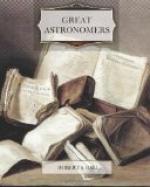[Plate: Frauenburg, from an old print.]
Once the issue had been placed in this form, the result could not be long in doubt. Here is the question: Which is it more likely—that the earth, like a grain of sand at the centre of a mighty globe, should turn round once in twenty-four hours, or that the whole of that vast globe should complete a rotation in the opposite direction in the same time? Obviously, the former is far the more simple supposition. But the case is really much stronger than this. Ptolemy had supposed that all the stars were attached to the surface of a sphere. He had no ground whatever for this supposition, except that otherwise it would have been well-nigh impossible to have devised a scheme by which the rotation of the heavens around a fixed earth could have been arranged. Copernicus, however, with the just instinct of a philosopher, considered that the celestial sphere, however convenient from a geometrical point of view, as a means of representing apparent phenomena, could not actually have a material existence. In the first place, the existence of a material celestial sphere would require that all the myriad stars should be at exactly the same distances from the earth. Of course, no one will say that this or any other arbitrary disposition of the stars is actually impossible, but as there was no conceivable physical reason why the distances of all the stars from the earth should be identical, it seemed in the very highest degree improbable that the stars should be so placed.
Doubtless, also, Copernicus felt a considerable difficulty as to the nature of the materials from which Ptolemy’s wonderful sphere was to be constructed. Nor could a philosopher of his penetration have failed to observe that, unless that sphere were infinitely large, there must have been space outside it, a consideration which would open up other difficult questions. Whether infinite or not, it was obvious that the celestial sphere must have a diameter at least many thousands of times as great as that of the earth. From these considerations Copernicus deduced the important fact that the stars and the other celestial bodies must all be vast objects. He was thus enabled to put the question in such a form that it could hardly receive any answer but the correct one. Which is it more rational to suppose, that the earth should turn round on its axis once in twenty-four hours, or that thousands of mighty stars should circle round the earth in the same time, many of them having to describe circles many thousands of times greater in circumference than the circuit of the earth at the equator? The obvious answer pressed upon Copernicus with so much force that he was compelled to reject Ptolemy’s theory of the stationary earth, and to attribute the diurnal rotation of the heavens to the revolution of the earth on its axis.




